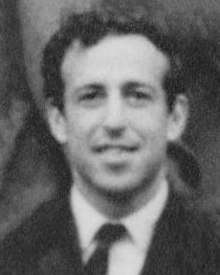Ben Roy Mottelson
Ben Roy Mottelson (born July 9, 1926) is a Danish nuclear physicist. He won the 1975 Nobel Prize in Physics for his work on the non-spherical geometry of atomic nuclei.
Ben Roy Mottelson | |
|---|---|
 1963 in Copenhagen | |
| Born | July 9, 1926 |
| Nationality | American-Danish |
| Citizenship | Danish |
| Alma mater | Purdue University, B.S. 1947 Harvard University, Ph.D. 1950 |
| Known for | Geometry of atomic nuclei |
| Spouse(s) | Nancy Jane Reno (1948-1975; 3 children) Britta Marger Siegumfeldt (m. 1983) |
| Awards | Atoms for Peace Award (1969) John Price Wetherill Medal (1974) Nobel Prize in Physics (1975) Marian Smoluchowski Medal (1980) |
| Scientific career | |
| Fields | Nuclear physics |
| Institutions | Nordita |
| Doctoral advisor | Julian Schwinger |
Early life
Mottelson was born in Chicago, Illinois, the son of Georgia (Blum) and Goodman Mottelson, an engineer. He graduated from Lyons Township High School in LaGrange, Illinois. He received a Bachelor's degree from Purdue University in 1947, and a Ph.D. in nuclear physics from Harvard University in 1950.
Career
He moved to Institute for Theoretical Physics (later the Niels Bohr Institute) in Copenhagen on the Sheldon Traveling Fellowship from Harvard, and remained in Denmark. In 1953 he was appointed staff member in CERN's Theoretical Study Group, which was based in Copenhagen,[1] a position he held until he became professor at the newly formed Nordic Institute for Theoretical Physics (Nordita) in 1957. He was a visiting professor at the University of California, Berkeley in Spring 1959.[2] In 1971 he became a naturalized Danish citizen.
In 1950–51, James Rainwater and Aage Bohr had developed models of the atomic nucleus which began to take into account the behaviour of the individual nucleons. These models, which moved beyond the simpler liquid drop treatment of the nucleus as having effectively no internal structure, were the first models which could explain a number of nuclear properties, including the non-spherical distribution of charge in certain nuclei. Mottelson worked with Aage Bohr to compare the theoretical models with experimental data. In three papers which were published in 1952–53, Bohr and Mottelson demonstrated close agreement between theory and experiment, for example showing that the energy levels of certain nuclei could be described by a rotation spectrum. This work stimulated new theoretical and experimental studies.
Nobel Prize (1975)
Rainwater, Bohr and Mottelson were jointly awarded the 1975 Nobel Prize in Physics "for the discovery of the connection between collective motion and particle motion in atomic nuclei and the development of the theory of the structure of the atomic nucleus based on this connection".[3]
Post-Nobel prize work
Bohr and Mottelson continued to work together, publishing a two-volume monograph, Nuclear Structure. The first volume, Single-Particle Motion, appeared in 1969, and the second volume, Nuclear Deformations, in 1975.
Professor Mottelson is a member of the Board of Sponsors of the Bulletin of the Atomic Scientists.[4]
He is an honorary member of the Finnish Society of Sciences and Letters and a foreign fellow of Bangladesh Academy of Sciences[5] and the Norwegian Academy of Science and Letters.[6] In 1969, he received the Atoms for Peace Award. He acted as director of ECT* (Trento, Italy) from 1993 to 1997.
Personal life
Mottelson is a dual citizen, as he holds both Danish and American passports. He lives in Copenhagen, Denmark. Mottelson was married to Nancy Jane Reno from 1948 until her death in 1975, and they had two sons and one daughter. Mottelson then married Britta Marger Siegumfeldt in 1983.[7]
References
- "Prof. Ben Mottelson". Scholarpedia. Retrieved 11 June 2015.
- "Ben R. Mottelson - Biographical". Nobel Foundation. Retrieved 1 June 2017.
- Nobel prize citation. Nobelprize.org. Retrieved on 2012-02-18.
- Bulletin of the Atomic Scientists – Board of Sponsors Archived 2009-04-20 at the Wayback Machine. Thebulletin.org. Retrieved on 2012-02-18.
- "List of Fellows of Bangladesh Academy of Sciences". Archived from the original on 2010-04-15. Retrieved 2016-08-04.
- "Gruppe 2: Fysikkfag (herunder astronomi, fysikk og geofysikk)" (in Norwegian). Norwegian Academy of Science and Letters. Retrieved 7 October 2010.
- "MTI ki kicsoda". 2009.
External links
- Nobel prize press release
- Ben Roy Mottelson on Nobelprize.org including the Nobel Lecture, December 11, 1975 Elementary Modes of Excitation in the Nucleus